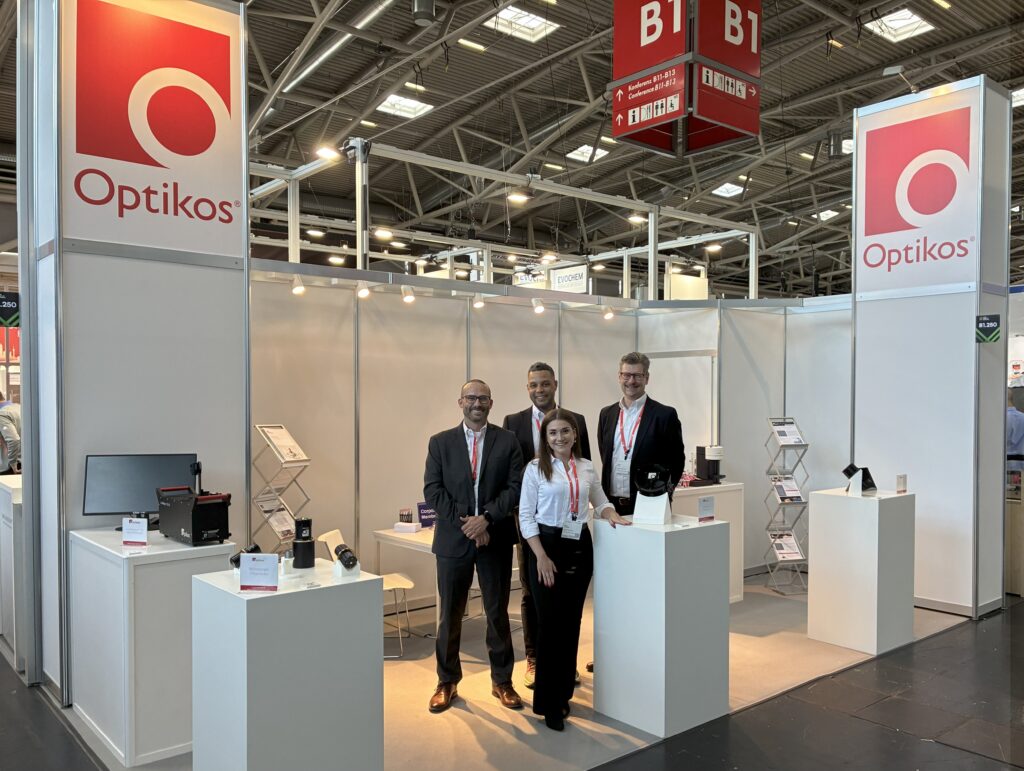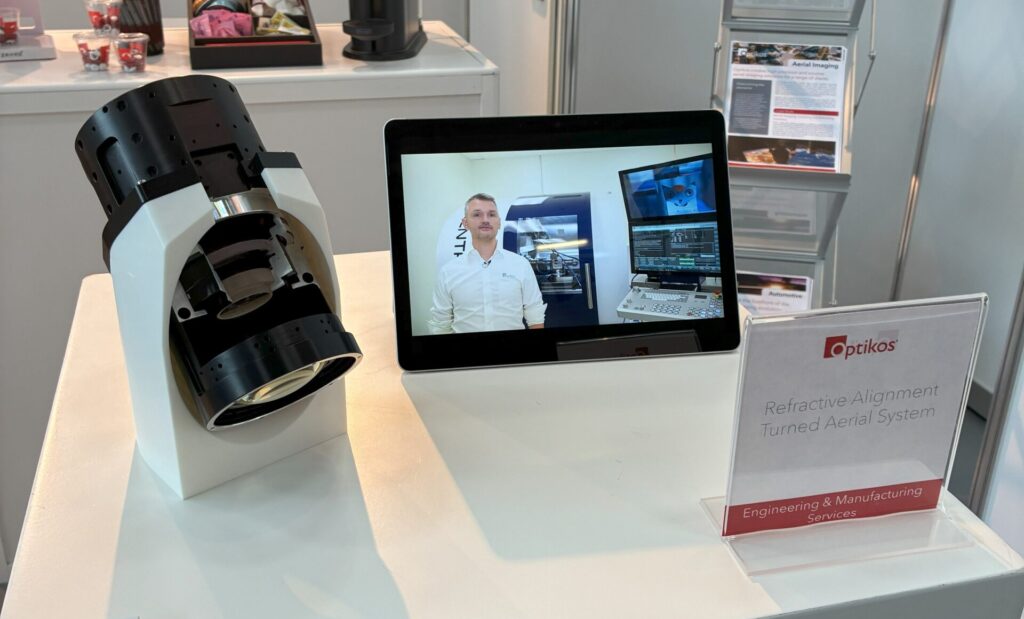With record numbers of 1,398 exhibitors and 44,000 participants, the 2025 edition of Laser World of Photonics, held in Munich, Germany was a testament to the growing demand for high-grade optical solutions. From the automotive sector in need of advanced sensor systems to the space telecommunication industry’s pull for high resolution space imagery, more markets are asking for stringently performing optics.
Optikos has been actively contributing to the major conversations taking place at Laser World of Photonics. By showcasing our unique suite of engineering capabilities and customizable solutions portfolio, we were able to foster a deepened interest in our Massachusetts-bred innovative edge for optical solutions (shoutout to everyone who asked about the OpTest® and LensCheck™ at our booth!). But we have also been put in the student seat, learning from tangent engineering verticals such as quantum engineering and robotics. That is how we have gained extensive insights into what our teams should be investigating next in terms of strategic scopes and projects. Being both industry leading optical engineers and avid tech aficionados provided us with the privileged position of drawing key observations about the optics sector and the directions it is taking.
Here are our top 3 key insights into the global photonics landscape from one of the leading trade fairs of the year:
- Quantum servicing surges – and it needs optics to grow exponentially
Laser World of Photonics has seen a 70% increase in exhibitors in the quantum space. This trend falls In line with other quantum-celebrating initiatives such as the 2025 International Year of Quantum Science and Technology, a global initiative hosted by the United Nations (UN). Within this exciting field, optics plays a crucial role for modern developments.
But this palpable rise in interest for quantum enabling technology and the need for high-performing optical systems and metrology should not come as a surprise though. For example, a 2015 scientific paper on “Quantum optical technologies for metrology, sensing and imaging” already announced that: “Over the past 20 years, bright sources of entangled photons have led to a renaissance in quantum optical interferometry. Optical interferometry has been used to test the foundations of quantum mechanics and implement some of the novel ideas associated with quantum entanglement such as quantum teleportation, quantum cryptography, quantum lithography, quantum computing logic gates, and quantum metrology.” Other optical solutions have been crucial catalysts to the development of the field. And the need for such powerful solutions is growing.
Optikos has started conversations on both the design-to-manufacture and the metrology side of our business for quantum-related solutions. By offering state-of-the-art optical platforms such as diffraction limited optical systems that support developments in AI, quantum computing, and high fluence data storage, we are giving a helping hand to one of the most exciting fields in humankind’s history. And we are doing that for both quantum technology manufacturing and testing.
- Robots and automation make perfect sense for optics manufacturing
Increasing customer specifications about product quality and intensifying market competition have led to a reality in which optical manufacturing cannot function in a lucrative way without automation. Scalable robots also come into play to aid with productivity, output performance, and cost efficiency.
Optikos is adopting several Industry 4.0 integrations regarding its automation strategy, by including collaborative robots in any design and manufacturing project that calls for process streamlining. The engineering teams at Optikos have the required capabilities for software programming and hardware development to facilitate automated cycles in all of our company verticals, from design and prototyping to end-to-end manufacturing and metrology.
Our most recent involvement with automation relates to a high-precision metrology order for augmented reality (AR) lenses, in which takt time has been halved thanks to our bespoke programming of robots that could manipulate high-volume batches of optical components in a precise, dependable, and fast manner.
Insights from Laser World of Photonics indicate this trend’s sustained trajectory. Basic automation has crossed the threshold from an optional to an essential infrastructure years ago. The next frontier involves implementing large-scale, sophisticated automated workflows to achieve optimal optical precision, all within cost-friendly budgets.
- Exploring the depths of biological and semiconductor research through advanced microscopy
At Optikos, we have been designing, assembling, and testing microscope systems for over four decades. So, when the news emerged at Laser World of Photonics that there is a surging growth in research involving high-performing microscopes, we were…honestly not surprised. This evolution, prompted by scientific developments in semiconductor manufacturing or biomedical applications such as gene therapy, immediately translates into a rise in the design and manufacturing of microscopy-ready optical systems. External trend forecasts like a recent BCC market report find that “the global microscopy market is experiencing significant growth driven by technological advancements, an increasing demand for high-resolution imaging, and a wider range of applications in life sciences, nanotechnology, materials science, and the semiconductor industries.”
In particular, high numerical aperture (NA) lenses are crucial for microscopes because they directly determine the fundamental imaging capabilities of the whole system. Optikos has integrated such insights a while back into our portfolio. That is how we were able to develop our curated library of pre-engineered objectives, something that meets our clients’ needs halfway in terms of quality, pricing, and delivery time. “We see these pre-engineered microscope solutions as the best way to continue meeting customer needs on shorter timelines and at lower costs”, says Sam O’Connor, Optical Engineer at Optikos. “Our APEX lenses, for example, exist at the intersection of customizability, manufacturability, and performance.”
“We see these pre-engineered microscope solutions as the best way to continue meeting customer needs on shorter timelines and at lower costs”, says Sam O’Connor, Optical Engineer at Optikos. “Our APEX lenses, for example, exist at the intersection of customizability, manufacturability, and performance.”
Our extensive work with optical solutions for microscopy, from fluorescence to confocal microscopy and beyond, makes us feel right at home with even the most complex client request. This is something we have tested throughout the conference in Germany via our client touchpoints and are keen on continuing now that we are back in our Boston office.
For Optikos, our participation at the 2025 Laser World of Photonics was a success from many points of view. The event was a great opportunity to catch up with colleagues and clients over the most exciting industry developments. If you have missed out on talking to us, don’t hesitate to get in touch now! We are looking forward to getting our hands and brains busy with innovation that moves Anywhere Light Goes™.



